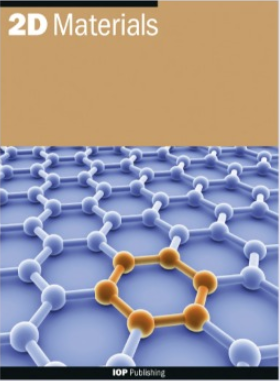磁场辅助氧化Fe3GeTe2薄片中圆形双壁畴晶格的稳定
IF 4.5
3区 材料科学
Q2 MATERIALS SCIENCE, MULTIDISCIPLINARY
引用次数: 0
摘要
二维铁磁体家族是新型自旋电子学应用的研究中心。在各种二维铁磁体中,fe3 GeTe 2由于具有高居里温度和易于剥离的范德华结构以及高自旋极化/大自旋轨道耦合而引起了人们的广泛关注。二维铁磁体中界面DMI的存在对磁畴壁的行为有着重要的影响,而磁畴壁是磁存储和逻辑器件的基础。通过控制界面DMI,可以控制畴壁的运动和磁畴结构,这对于开发高效可靠的磁性器件至关重要。在这项研究中,我们研究了反转对称破缺氧化层对fe3 GeTe 2薄片磁畴结构的影响,这是由于界面DMI的出现。通过结合磁光克尔效应显微镜图像和微磁模拟,我们研究了在特定的场冷却和磁场扫描方案下氧化薄片中圆形双壁(CDW)畴晶格的形成。它们的形成归因于对称和反对称交换相互作用(与界面DMI有关)、磁晶各向异性和外部磁场之间的竞争。CDW结构域的直径为几微米,是一种类似于skyrmionium的磁性结构,排列在规则的晶格中,可以在接近温度的温度波动中存活下来。我们的研究结果表明,这些CDW结构域在磁场阈值后转变为nsamel型skyrmions。这些发现可能对自旋电子应用的二维铁磁材料的设计和优化具有重要意义。本文章由计算机程序翻译,如有差异,请以英文原文为准。
Magnetic field assisted stabilization of circular double wall domain lattice in oxidized Fe3GeTe2 flakes
Abstract The family of 2D ferromagnets is in the center of research for novel spintronics applications. Among the various 2D ferromagnets, Fe 3 GeTe 2 has drawn significant attention since it combines a high Curie temperature with a van der Waals structure, which allows easy exfoliation, and a high spin polarization/large spin–orbit coupling. The presence of interfacial DMI in 2D ferromagnets have a significant impact on the behavior of magnetic domain walls, which are fundamental in magnetic memory and logic devices. By controlling the interfacial DMI, it is possible to manipulate the motion of domain walls and the magnetic domain configuration, which is essential for the development of efficient and reliable magnetic devices. In this study, we investigate the effect of an, inversion symmetry breaking, oxidized layer on the magnetic domain structure of Fe 3 GeTe 2 flakes due to the emergence of interfacial DMI. By combining magneto-optical Kerr effect microscopy images and micromagnetic simulations, we study the formation of a circular double wall (CDW) domain lattice in oxidized flakes under specific field cooling and magnetic field sweeping protocols. Their formation is attributed to a competition between the exchange interaction both symmetric and antisymmetric (associated to interfacial DMI), magnetocrystalline anisotropy and the external magnetic field. The CDW domains have a diameter of several microns, a magnetic structure resembling that of a skyrmionium and are arranged in regular lattice that survives thermal fluctuations close to T c . Our results suggest that these CDW domains transition to Néel type skyrmions after a magnetic field threshold. These findings could have important implications for the design and optimization of 2D ferromagnetic materials for spintronic applications.
求助全文
通过发布文献求助,成功后即可免费获取论文全文。
去求助
来源期刊

2D Materials
MATERIALS SCIENCE, MULTIDISCIPLINARY-
CiteScore
10.70
自引率
5.50%
发文量
138
审稿时长
1.5 months
期刊介绍:
2D Materials is a multidisciplinary, electronic-only journal devoted to publishing fundamental and applied research of the highest quality and impact covering all aspects of graphene and related two-dimensional materials.
 求助内容:
求助内容: 应助结果提醒方式:
应助结果提醒方式:


